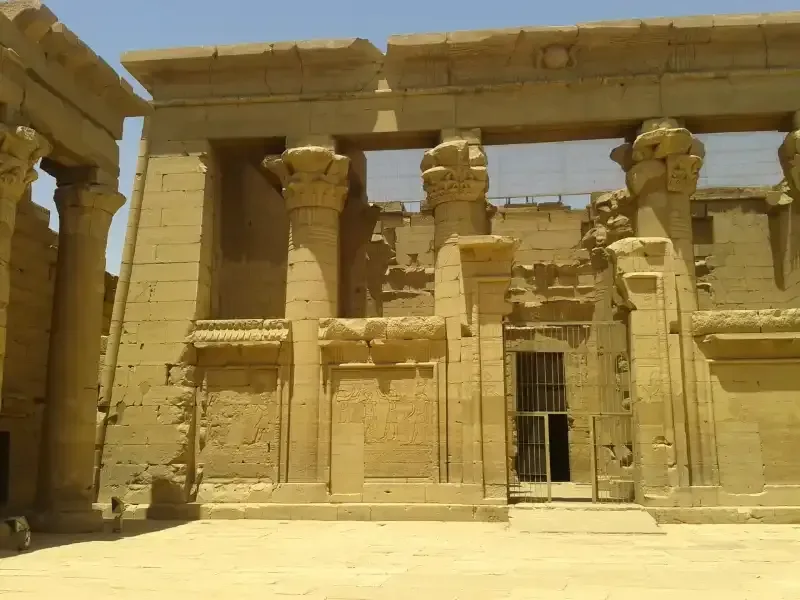Kalabsha Temple- Aswan
Introduction
Nestled on the serene shores of Lake Nasser in southern Egypt, Kalabsha Temple stands as a testament to the enduring legacy of ancient Egyptian architecture and spirituality. This magnificent temple, relocated from its original site due to the construction of the High Dam, offers visitors a rare glimpse into Egypt's rich cultural heritage. From its impressive structure to its storied history, Kalabsha Temple beckons travelers to delve into the mysteries of ancient Egypt's past.
Importance and Significance
Kalabsha Temple, dedicated primarily to the Nubian sun god Mandulis, holds profound religious and historical significance. Constructed during the Roman era, between 30 BC and 14 AD, the temple represents a unique blend of Egyptian and Greco-Roman architectural styles. It served as a place of worship and a symbol of cultural exchange between ancient civilizations, reflecting Egypt's diverse and complex religious landscape during that period.
Location and Accessibility
Kalabsha Temple is situated approximately 50 kilometers south of Aswan. Kalabsha Temple is easily accessible by road or boat. The temple's relocation to its current location on New Kalabsha Island was a monumental effort overseen by UNESCO in the 1970s, ensuring its preservation amidst the rising waters of Lake Nasser. The journey to Kalabsha Temple itself offers breathtaking views of the Nile River and the surrounding desert landscapes, adding to the allure of the visit.
History and Evolution
Kalabsha Temple was commissioned by Emperor Augustus and later expanded by Emperor Tiberius. Kalabsha Temple is one of the largest freestanding temples in Nubia. Its construction marked a continuation of the ancient Egyptian tradition of temple building, albeit with a distinctive Roman influence. The relocation of Kalabsha Temple was part of UNESCO's ambitious project to salvage numerous ancient sites threatened by the creation of Lake Nasser, making it a poignant symbol of international cooperation in cultural preservation efforts.

Exploring Kalabsha Temple
Visitors to Kalabsha Temple are greeted by its impressive pylons and well-preserved hypostyle hall, adorned with intricate hieroglyphics and vivid depictions of ancient Egyptian deities. The temple's main sanctuary houses a colossal statue of the Nubian god Mandulis, emphasizing its role as a center of religious reverence and spiritual contemplation. The craftsmanship and artistry evident throughout the temple offer a captivating glimpse into the artistic achievements of ancient Egypt.
Practical Information for Visitors
- Opening Hours: Kalabsha Temple is open daily from 7:00 AM to 4:00 PM.
- Entrance Fees: Admission fees are moderate, with discounts available for students and children.
- Guided Tours: Knowledgeable guides are available on-site to provide insightful commentary and historical context.
- Facilities: Basic amenities such as restrooms and a visitor center are available nearby.
Fun Facts and Hidden Gems
- Hieroglyphic Marvels: Marvel at the well-preserved hieroglyphs and reliefs depicting scenes from ancient Egyptian mythology, offering insights into daily life and religious practices.
- Temple Relocation Feat: Learn about the engineering marvel involved in relocating Kalabsha Temple and other historic sites to their current locations, preserving them for future generations.
- Nubian Influence: Discover the unique blend of Nubian and Egyptian artistic styles in the temple's architecture and artwork, reflecting the region's cultural diversity.
Tips for a Memorable Visit
- Early Morning Advantage: Visiting early morning to avoid crowds and experience the temple's tranquil ambiance, allowing for deeper exploration and reflection.
- Sun Protection: Aswan's climate can be hot and dry; it's advisable to bring sunscreen, a hat, and plenty of water to stay comfortable during your visit.
- Photography: Capture the temple's majestic architecture and picturesque surroundings, but be respectful of signage and avoid flash photography in sensitive areas.
- Local Cuisine: Explore nearby cafes and restaurants to savor authentic Nubian and Egyptian dishes, complementing your cultural experience.
Conclusion
Kalabsha Temple stands as a testament to the enduring legacy of ancient Egypt, inviting visitors to embark on a journey through millennia of history and spirituality. Whether you're a history enthusiast, a cultural explorer, or simply seeking to immerse yourself in Egypt's timeless allure, a visit to Kalabsha Temple promises an enriching and unforgettable experience. From its architectural grandeur to its profound symbolism, Kalabsha Temple offers a window into the artistic achievements and spiritual beliefs of ancient civilizations, set against the tranquil backdrop of Lake Nasser's azure waters. Plan your visit today and embark on a voyage of discovery unlike any other, where the echoes of Egypt's past resonate through every stone and inscription.



